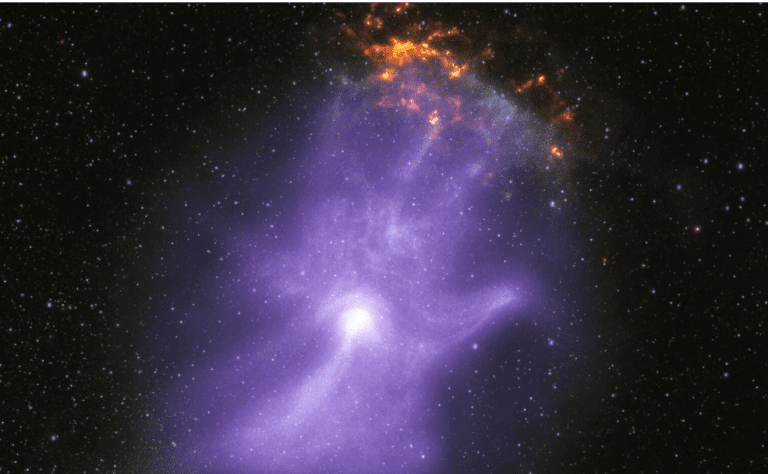
There are numerous Bible verses describing space and the heavens. God took His time while creating space as we know it, so it’s natural to see His hand in everything. On the fourth day of creation, God created the sun, moon, and stars, showcasing His dominion and power, but did NASA just discover the hand of God?
NASA’s two advanced X-ray space telescopes recently highlighted an astonishing image: the “bones” of a hand-shaped structure reaching out into the vast expanse of space. This celestial formation starts from the remnants of a collapsed star, spewing out plumes of energized matter and antimatter.
NASA researchers liken the findings to the very origins of X-rays, which date back to 1895 and German physicist William Röntgen. While experimenting with cathode rays using a Crookes tube, an early experimental electrical discharge tube, he noticed a fluorescent glow in a nearby chemically coated screen. The tube was surrounded by black cardboard, which should’ve prevented any light from escaping, yet the screen still glowed.
Röntgen soon discovered that this new type of ray could penetrate through most substances, including human tissue, but left bones and metals visible. Recognizing the potential of his discovery, he took an X-ray photograph, or radiograph, of his wife Anna’s hand, clearly showing her bones and her wedding ring. Because he didn’t know the nature of these rays, he named them “X-rays,” with “X’ representing the unknown.
So, where did this cosmic “hand” come from? About 1,500 years ago, a colossal star in our galaxy consumed all its nuclear fuel. This event led the star to collapse into itself, resulting in the formation of a neutron star. These types of stars, especially the rotating ones with powerful magnetic fields known as pulsars, are akin to cosmic laboratories. They exhibit extreme physical phenomena that can’t be duplicated here on Earth. One of the most intriguing manifestations of young pulsars is the “pulsar wind nebula,” a spectacle formed by the rapid jets of matter and antimatter propelled away from the pulsar.
Almost 20 years ago, NASA’s Chandra X-ray Observatory first spotted the pulsar PSR B1509-58. It revealed a pulsar wind nebula looking strikingly like a human hand, which was aptly named MSH 15-52. The pulsar can be found at the “palm” of this cosmic hand situated 16,000 light years from our planet. NASA’s newest X-ray telescope, the Imaging X-ray Polarimetry Explorer (IXPE), recently spent 17 days observing this celestial marvel.
“The IXPE data gives us the first map of the magnetic field in the ‘hand,'” says Roger Romani of Stanford University, who spearheaded the research, in a statement. “The charged particles producing the X-rays travel along the magnetic field, determining the basic shape of the nebula, much like bones shape our hand.”
One standout feature of MSH 15-52 is a radiant X-ray jet stretching from the pulsar to the “wrist” of the hand-shaped structure. The IXPE data exposed the intricacies of this jet. At its inception, the polarization is minimal, indicating a turbulent area with entangled magnetic fields. However, as you move further along the jet, the magnetic field lines straighten, leading to increased polarization.
Psalms 8:3-4 reads, “When I consider your heavens, the work of your fingers, the moon and the stars, which you have set in place, what is mankind that you are mindful of them, human beings that you care for them?” God created the heavens and stars, but the discovery of this hand may prove that His work isn’t done yet.
